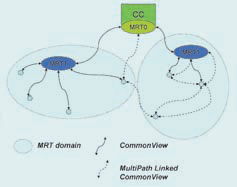| GNSS, TIME | |
Synchronet – an innovative system
Franco Gottifredi, Monica Gotta, Enrico Varriale, Daniele Cretoni
|
||||
| To solve this problem GNSS based techniques have been preferred over other methods for many reasons, among which: • availability of the GNSS navigation signals • performances • diagnostic information about GNSS system health. GNSS based synchronization could be carried out by mean of the CommonView technique which exploits navigation signals broadcasted by GNSS SVs (Space Vehicles) which are in a condition of “common view” from the observation points of the two sites to synchronize. Figure 3: SynchroNet network topology A schematic representation of this method and the related process is The CommonView method is very simple in its theoretical formulation From the sketch above, can be identified at least two such issues: Delays to be compensated are mainly due to the propagation in the atmosphere (i.e. Ionosphere and Troposphere). For each segment a delay factor is computed using mathematical models. The residuals of delay corrections are among the limiting factors for the Common View While Delays affect only the synchronization computation, Data Exchange affects, also, other aspects that system designers have to take into account: Synchronet Overview SynchroNet is a distributed approach to synchronization with centralised monitoring and control facilities (see Figure 2). To provide a synchronization system that deals with all issues described in the previous paragraph, SynchroNet implements a networked infrastructure around the core time transfer algorithms and distributes the synchronization process over a hierarchic network with hierarchic network nodes roles. This approach allows to distribute and keep balanced the processing load and limits the propagation of failures. In the SynchroNet system three kinds of nodes are present: Figure 3 provide an overview of the SynchroNet network topology The Control Centre provides centralised monitoring of each node of the network in terms of equipment health status, connection link and security and synchronization performances. The CC is also responsible for network management allowing the supervisor to change the network topology (add a new node, remove a node, assign a node to a Figure 4: Preliminary analysis tool for optimal baseline determination Figure 5: Number of satellites in common view for different baselines MRTs are the distributed time references and form the hierarchic synchronization backbone of the system. Each MRT computes synchronization of the allocated SyNs and receives the synchronization SyNs are the leaves of the graph representing the SynchroNet network; SynchroNet is characterized, at each level, by a strong modularity of its Each SynchroNet node can be seen as a functional logical entity composed by many sub modules interacting with each other by mean of well defined interfaces and protocols; this means that a single node deployment may span many physical/ virtual machines. Each sub module is well defined in terms of pre and post conditions and |
||||















 (No Ratings Yet)
(No Ratings Yet)





Leave your response!